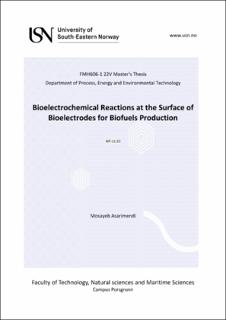| dc.description.abstract | In most countries, the major energy source is fossil fuels. Fossil fuels are cost-effective and reliable. But it faces the issue of greenhouse gas (GHG) emissions. Therefore, new renewable energy sources must be developed. Utilizing bioelectrochemical synthesis for the production of methane is a promising process. This study aims to provide a method for determining the features of a complex bioelectrochemical system (reactor). The method attempted to explain relevant biochemical reactions at the electrodes and establish the reaction's thermodynamic properties as Gibbs free energy. A fundamental aspect of this method was determining the relationship between Gibbs free energy and the applied voltage in the bioelectrochemical system. The main principle of the model was based on McCarty and Heijnen's analysis of the reaction's stoichiometry. The relationship between stoichiometry, Gibbs free energy, and the applied voltage is specified using the Nernst equation. Relevant biochemical reactions were determined, and acetate, glucose, ammonium, and hydrogen were selected for parameter assessment. Considering the effects of temperature, pressure, and energy fraction on yield and stoichiometry, pressure has the most significant influence on the applied voltage. As the pressure rises, the needed voltage falls.
Furthermore, changes in the energy fraction could affect the stoichiometry of a reaction. In practice, this change will have little effect on the applied voltage if other variables are not taken into consideration. According to the research, if there are more accessible electrons, the reaction will be more spontaneous with less voltage.
In addition, a rise in temperature causes an increase in applied voltage, which can have a negative effect on the system. It can be shown that the temperature should be within an acceptable range that does not inhibit microbial population growth.
Glucose oxidation has the highest applied voltage value among the evaluated substrates in regards that it has a higher yield than the other relevant compounds. Furthermore, the findings show that the ammonium oxidation process requires the least amount of voltage. | |
